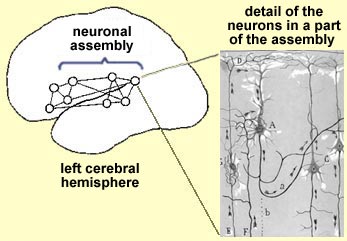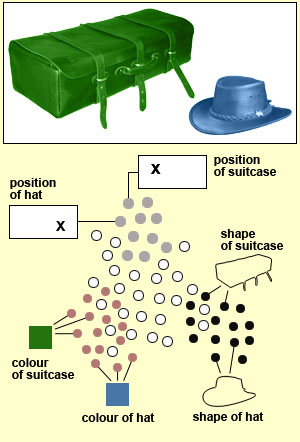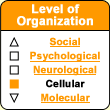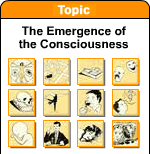|
|
|
|
 |
The
Sense of Self |
 |
|
|
|



“I
have it at the tip of my tongue!”
Brain
Rhythms: The Oscillations That Bind
A neuronal assembly is
a group of neurons that maintain strengthened
synaptic connections with one
another, so that they are more likely to be active all together
at the same time.
The neurons in these assemblies are not necessarily all
physically close to one another. They can be distributed
across various parts of the brain. Moreover, a single neuron
can belong to several different assemblies and can be recruited
into new assemblies at any time. Thus neuronal assemblies
are not stable, but dynamic, and not necessarily localized,
but often distributed.
Neuronal assemblies are also known to have other properties
that must be accounted for in models of consciousness. For
example, we know that even if only part of a neuronal assembly
is activated initially, this activation, if it reaches a certain
threshold, may then be propagated across the entire assembly.
Thus, if just a portion of a memory is successfully activated
in your brain, that may cause the entire neuronal assembly
in question to become activated, thus filling in the lapses
or gaps in this memory and enabling you to
recover it in its entirety.
A phenomenon that is in a sense the opposite also occurs:
some neuronal assemblies that initially have nothing to do
with one another but that are repeatedly activated at the
same time become more strongly connected. This is in fact
the fundamental
principle of learning at the cellular level, the
mechanism by which our brains let us store the world’s
regularities in our memories, which of course has a definite
adaptive value . |
A number of phenomena
support the argument that the neuronal assembly is the smallest
possible physical substrate for a meaningful mental representation.
Isolated neurons die in the brain every day, but an entire
piece of knowledge suddenly disappears only when areas of
the brain that contain large numbers of neurons are destroyed.
The brain’s ability to store new pieces of information
in declarative
or procedural memory has no defined limit. Because
there are already such
a tremendous number of neurons in the brain,
the combination of these neurons into various assemblies that
can also have elements in common makes the number of possible
representations practically infinite as well.
|
|
|
| NEURONAL ASSEMBLIES AND SYNCHRONIZATION OF BRAIN
ACTIVITY |
|
How does a conscious idea come into your
mind, and by what mechanisms does your consciousness move from
one idea to another? Neurobiological
models of consciousness offers some interesting new approaches
to these age-old questions.
To begin our discussion of these models,
we should note two things. First, these models fall within the
philosophical framework of materialism.
Second, the general hypothesis of these models is that there are “neural
correlates” of consciousness—in other words, that
any change in our mental states necessarily involves a change in
the states of our neurons.
 |
More specifically, most
of these models agree that our sensory perceptions as well
as our more abstract thoughts correspond to the activity of
vast networks or assemblies of neurons, an
activity that is subject to a complex set of dynamics (see
sidebar). |
Most of these models also recognize that
at any given time, the brain is processing far
more information than we are aware of. To cite only one example,
regarding our sense of vision, we
have the false impression that we are consciously aware of everything
that lies in our field of vision, but actually, we consciously
experience only a small portion of this scene.
In fact, at any given moment, we can be conscious
of only one thing, even though the things of which we are conscious
may follow each other in very rapid succession. What is it then
that enables us to distinguish between the multitude of information
that we process unconsciously and the unique content of our conscious
mind at any given time?
In neuronal terms, the question can be stated
as follows: which assembly of neurons will become the one whose
activity is associated with a conscious thought at any given time?
In a sense, the various neuronal assemblies are competing to pass
through the narrow gateway into consciousness. Is it enough then
to say that those neuronal assemblies that are the most active
will form the contents of the conscious mind?
Actually, when we try to explain the difference
between the conscious and the unconscious solely in terms of the
amount of neuronal activity, a major problem arises: the brain
already uses the activity level of neurons (physically expressed
by the frequency of the nerve impulses that they emit) to
represent the intensity of stimuli (for example, whether
a light is brighter or dimmer, or a sound is louder or quieter).
The frequency of nerve impulses cannot simultaneously
indicate the intensity of a stimulus and whether or not it is a
conscious one. Hence there must be some other mechanism by which
a piece of conscious content is selected. How then does the brain
manage to distinguish a stimulus that is intense but unconscious
(for instance, the words of a song that is playing very loud on
a jukebox but that you’re not listening to) and a stimulus
that is less intense but conscious (such as the sweet words that
your lover whispers in your ear and that you are very much aware
of)?
The brain must have some other mechanism
that lets it assess the objective importance of a stimulus and
at the same time distinguish between conscious and unconscious
mental representations. This mechanism must also account for another
problem that doesn’t seem like one if you don’t consider
how sensory information is processed in the brain, but that becomes
a real puzzle if you do.
This problem arises from the fact that the
brain uses numerous specialized circuits to process the various
properties of perceived objects in parallel. For example, when
you are looking at a hat, differing
visual areas in your brain’s occipital cortex will process
differing properties of the hat. Some of these areas will be sensitive
to the hat’s outline, while others will be sensitive to its
colour, or its shape, or its texture, or its location in space,
and so on. You can see what the problem must then be: how does
your brain manage to integrate all these properties, which have
been decoded at different locations, in order to give you the subjective
perception of a single object: a hat?

(After Engel et al.,
1999) |
But things
can get even more complicated. For example, what happens
when you see a green suitcase next to a blue hat? Your brain’s
visual areas for colour register the green and the blue,
those for shape register a rectangle and a rounded form,
those for position register one object to the left and another
to the right, and so on. But where in the brain are the characteristics
of each of these objects put together to form your conscious
perception of two distinct objects, without confusing the
characteristics of one with those of the other? That is the
problem, referred to in neuroscience as the binding
problem. |
This problem of how the various properties
of an object are bound into a single, conscious, coherent perception
is closely linked with the process by which we select those neuronal
assemblies that will leave the unconscious and enter into consciousness.
Among the various mechanisms that some scientists
have proposed to address these two problems, the
synchronization of neuronal oscillations is certainly one of
the most controversial. Other scientists have gone even further, by
positing that there is a second system of temporal synchronization
in addition to the first one.
Can
conscious phenomena be associated with the activity of a
particular type of neuron? Obviously, things can’t
be that simple. But some scientists do believe that a particular
type of neuron—the large, elongated, spindle-shaped
nerve cells known as VEN neurons—may
play a significant role in consciousness .
The name VEN neurons comes from the
initials of the neurologist Constantin
von Economo, who was the first to describe
these neurons, in 1925. VEN neurons are bipolar
neurons located exclusively in layer
V of the anterior
cingulate cortex and the insula. These neurons
are found only in the great apes and in human beings. And
as if by chance, it is humans who have by far the greater
number of these neurons. This suggests that these neurons
appeared quite late in the history
of the brain’s evolution, something like
15 million years ago.
The relative recency of VEN neurons
from an evolutionary standpoint, together with their location
in the areas of the frontal lobe that are involved in our
higher cognitive functions, have made them a focus of attention
in certain
neurobiological models of consciousness. The morphology
and location of these neurons in fact suggest that they receive
a wide range of stimuli which they may integrate and process
very rapidly.
|
|
|






